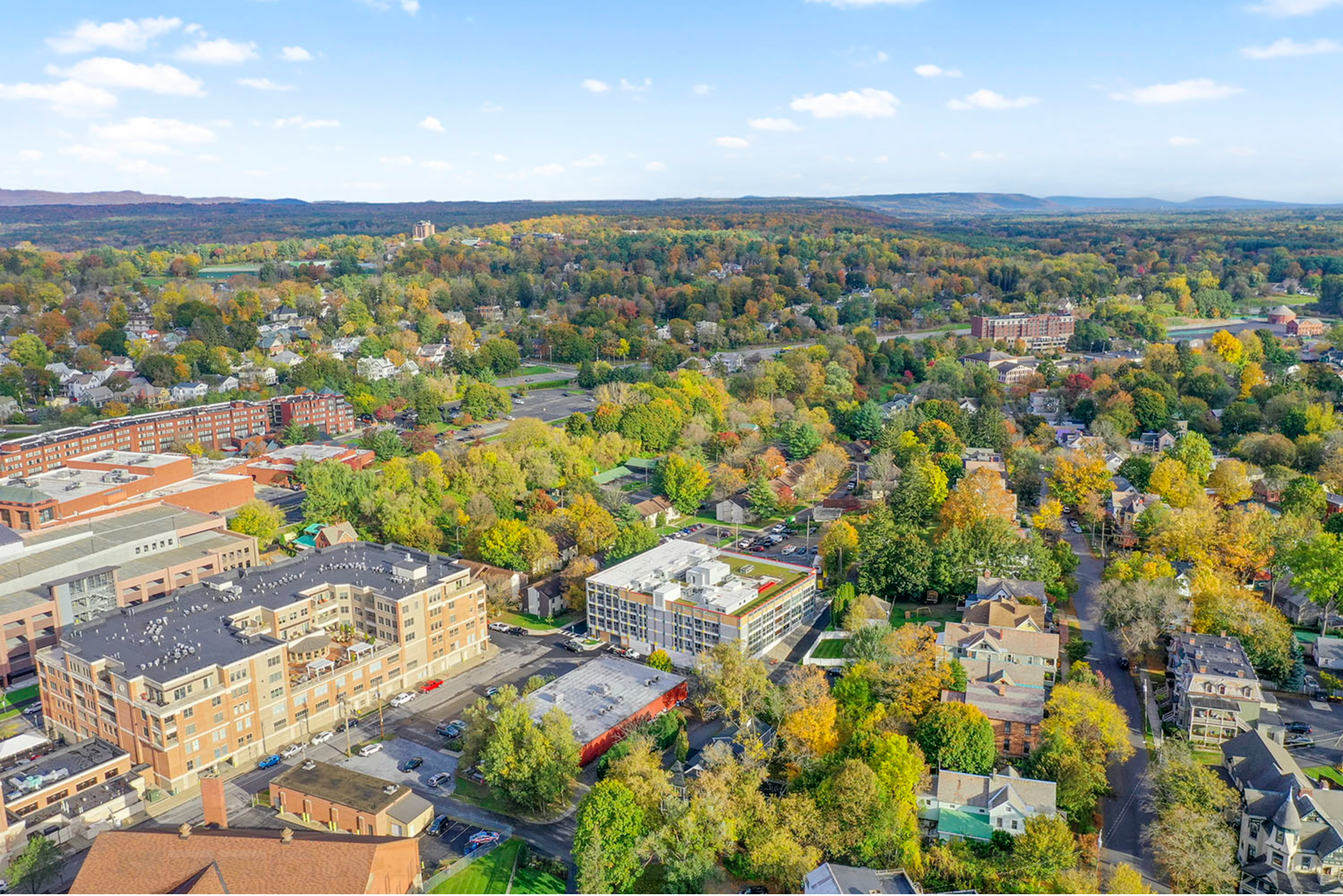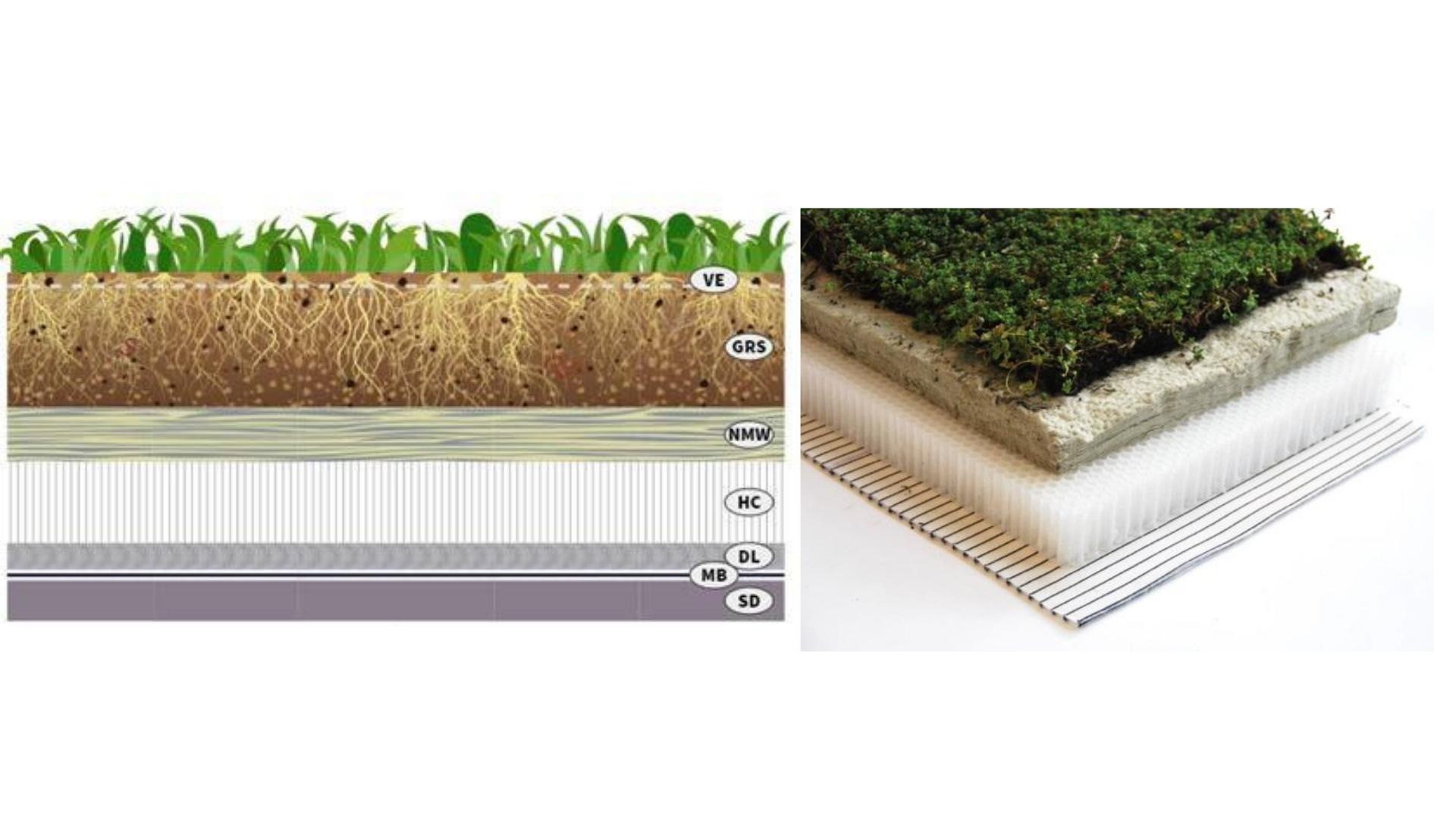Rooftop Detention Can Save You Money
Advertisement
Green Roofs Can Do More
Many readers who are familiar with GRD’s work probably already know that in saying “Green roofs can do more,” a big part of the “more” that GRD has identified is providing stormwater detention. Urban stormwater management usually deals with two primary practices: retention and detention. Retention is the reduction of runoff; water is absorbed by green roof media and plants and never runs off the roof. Instead, retained water leaves the roof only as vapor through evapotranspiration. All green roofs provide retention to varying degrees based on climate, profile composition, and thickness.
Detention is the practice of slowing down water that does runoff. As it is impractical – or even impossible – to retain all stormwater on a green roof all the time, detention is often necessary to ensure minimal negative downstream impact of runoff, particularly reduction of combined sewer overflows (CSOs). Most stormwater permits require detention, but most green roofs do not provide any statistically significant detention.
As developers are required to comply with retention and detention requirements, adding detention to the range of benefits that green roofs provide may provide significant return-on-investment (ROI) to the developer.
An aerial shot of the Moderne, Saratoga Springs, NY, designed by Design Logic Architects, which saved more than $500,000 with stormwater detention technology. Photo: Bonacio Construction
Advertisement
The Moderne, Saratoga Springs
The Moderne is a new 5-story condominium located in Saratoga Springs, New York. Constructed in 2021, it contains a mix of 24 high-end residential units with exterior and underground parking. It also includes an 11,000 sf (1020 m2) rooftop amenity space with a green roof.
Microburst over a city. A soaked traditional green roof profile cannot manage this intensity of rainfall, which is why an additional at-grade stormwater solution, or a detention green roof may be required.
The original green roof design was a traditional profile, consisting of 5” (125mm) deep growing media and sedum mat over a standard drainage panel.
While traditional green roofs have many benefits, without the use of additional tank systems, they do not provide a consistent and accepted means of complete stormwater management. The originally proposed 5” (125mm) deep profile will retain a large amount of water when relatively dry. In fact, it will entirely capture most small storms, of one inch or less. But once it’s fully saturated, any additional stormwater that falls on it will flow to the roof drain and ultimately to the sewer system. This results in very high peak flow rates during large storms, which can contribute to localized flooding and CSOs.
To combat overflows and related damages, stormwater management has become an even more critical element of design and is considered in the early stages of project planning. Most jurisdictions have developed extensive regulations and requirements to help reduce overflows. When permitting, some jurisdictions require that designs must demonstrate the capability to capture small storms and manage the larger, 100-year frequency storms.
These requirements meant that any project with a green roof would still require another method of stormwater management, thereby limiting the ROI of the green roof to less-tangible but still desirable benefits such as partial stormwater management, noise, and heat reduction, improved air quality, building energy savings, biodiversity, and tenant health and well-being.
In the search for a better solution, many options were considered. It was determined that by upgrading the traditional green roof assembly with new components that provide the missing detention, a green roof could be a complete solution to managing stormwater and eliminating the need for additional systems, such as tanks, to supplement.
In this case, the Purple-Roof© Concept was implemented to address the “too much water” challenges with retention and the “too little time” challenge with detention.
Advertisement
The Green Roof Stormwater Challenge
The original stormwater plan specified a traditional 6,000 cf (170,000L) stormwater tank to be buried beneath the parking lot. However, due to the high water-table, site grading, and poor soils, an exterior tank was determined not viable without a major redesign and the loss of multiple outdoor parking spaces. Due to local zoning requirements, the loss of any parking spaces would also trigger the loss of units the owner could develop and sell. Therefore any loss of parking was not an economically viable option.
The design team was presented with the task of finding a new means of managing stormwater. Because construction had already begun, a solution had to be found quickly. After extensive review, the two best options were determined and presented to ownership.
Available Stormwater Options
Left: Traditional green roof profile originally proposed. Layers from top to bottom: vegetation (VE), 5 inches (125mm) green roof soil [media] (GRS), filter fabric (FF), drain plate (DP), membrane (MB), structural deck (SD). Right: mockup of same profile (thicknesses may vary). Photo: Green Roof Diagnostics
Left: Purple-Roof© Concept profile. Layers from top to bottom: vegetation (VE), 5 inches (125mm) green roof soil [media] (GRS), 2 inches (50mm) needled mineral wool (NMW), 3 inches honeycomb reservoir (HC), detention layer (DL), membrane (MB), structural deck (SD). Right: mockup of same profile (thicknesses may vary). Photo: Green Roof Diagnostics
In this project, the design storm was an NRCS Type II, 100-year, 5.9” (150mm), 24-hour storm. The required storage volume was 6,000 cf (170,000L), and the maximum allowable outflow rate from the site was 0.4 cf/s/a (28 L/s/ha). The two options being considered by the developer to meet these requirements were:
Option 1: Install a traditional storage tank and pump system inside the building. That would require approximately 1,200 sf (112m2) of interior space, and was originally estimated to cost roughly $75,000 to install, and require ongoing annual inspections and maintenance. However, a revised construction cost estimate set the fully installed cost of the tank system at close to $900,000, as the building was sited on poor soils with a high water table, and had to utilize a pile foundation. This excessive cost would have been a major financial blow to the project and was therefore rejected.
Option 2: Manage the stormwater on the roof. Using the Purple-Roof© Concept, the existing green roof could be upgraded to provide the required storage and outflow control by replacing the standard drain plate with needled mineral wool, a honeycomb reservoir, and a detention layer.
The Green Roof Detention Solution with an ROI
Considering cost as a significant factor, and with New York having some of the highest real estate prices in the country, it was critical to maximize the square footage that the owner could develop and sell. The ideal solution would manage the stormwater without reducing the marketable square footage.
GRD calculated that by incorporating the Purple-Roof© Concept into the 10,910 sf (1,020m2) traditional green roof already specified, that the Purple-Roof system would provide stormwater management without the need for any tanks or additional infrastructure. The decision was made to upgrade the green roof and eliminate the tank system.
The needled mineral wool layer provides excellent retention and filtration properties while minimizing weight. The honeycomb detention reservoir provides storage that is always functioning regardless of the soil saturation level. Its thickness is engineered to meet the project-specific requirements. The detention layer provides controlled and consistent outflow at an engineered rate over the entire green roof area.
Advertisement
Financial Savings
By managing the stormwater on the roof, the developer:
Provided 6,336 cf (179,415 L) of stormwater storage, equal to the volume of 5+ shipping containers (shown to scale below)
Reduced the peak runoff from a 100-year storm by 95%, and a 42-hour drain down delay
Kept 26 semi-truckloads of debris from being excavated, hauled, and dumped in landfill.
Graphic representation of the originally proposed size of the subgrade stormwater tank, approximately the size of five (5) shipping containers. Photo: Green Roof Diagnostics
Hydrograph modeling rainfall (blue) versus runoff (red). At the peak of the Type II 100-year design storm, the proposed detention green roof solution reduces peak outflow rates by 95 per cent. Photo: Green Roof Diagnostics
By managing the stormwater on the roof, the developer built and sold the 1,200 sf (112 m2) of salvaged interior space at the market rate of $550 per sf, adding $540,000 to the developer’s sales revenue. The savings is even greater if the $900,000 revised estimate for a tank system is considered versus the original (standard foundation) $75,000 tank system estimate.
Financial Breakdown
Cost of traditional 6,000 cf stormwater tank system: $75,000
Cost of 11,000 sf green roof upgrade: $195,000
Total added cost for Purple-Roof (versus a traditional green roof): $120,000
Added square footage by removal of stormwater tank system: 1,200
Market SF rate: $550/sf
Added Gross Revenue to Developer: $660,000
Subtract Premium For Purple Roof: $120,000
Added Net Revenue to Developer: $540,000
Getting more out of your green roof, as this case study demonstrates, often requires thinking differently about stormwater management, and conducting a thorough analysis to determine the cost effectiveness of traditional approaches such as tanks. In areas where land costs are high, retaining and detaining stormwater on green roofs may supply the ideal solution.
Advertisement
Brad Garner is the CEO of Green Roof Diagnostics is an independent research and testing company that focuses on quantifying and improving the performance of green roofs. They perform first-hand research, and we work with a range of academic institutions, manufacturers, regulators, and engineers to bring the latest proven scientific advancements into the marketplace.
More Information
The Purple-Roof © Concept is an innovative approach to green roofs that creates stormwater detention via friction. This concept is incorporated into product lines offered by Sempergreen, Sempergreen USA, Next Level Stormwater Management, Stormwater Capture Co., Knauf Insulation, American Hydrotech, and others.
Project Team
Developer and General Contractor: Bonacio Construction
Architect: Design Logic Architects
Green Roof Installer: Apex Green Roofs
Green Roof Supplier: Sempergreen USA










